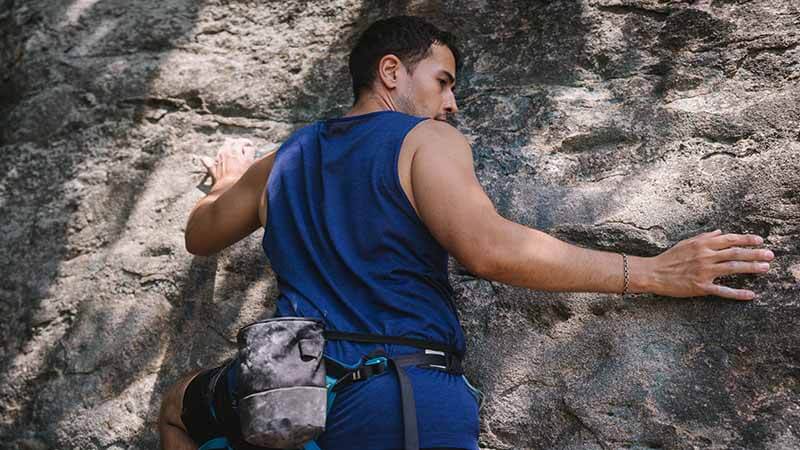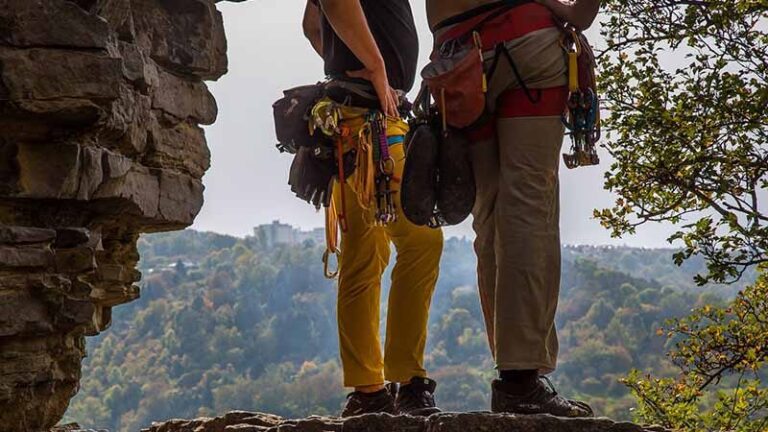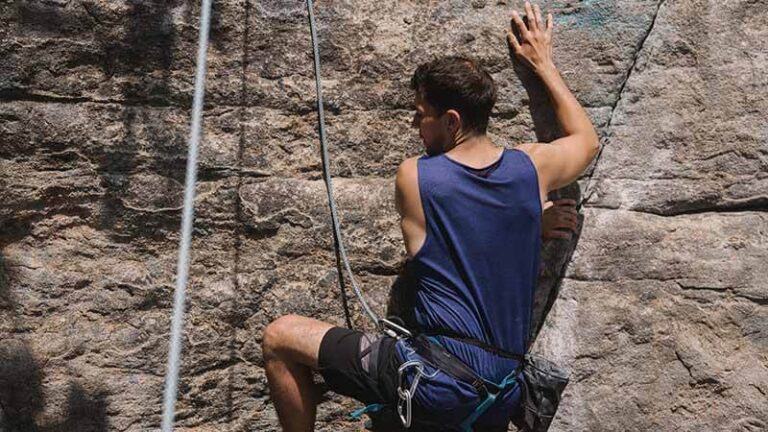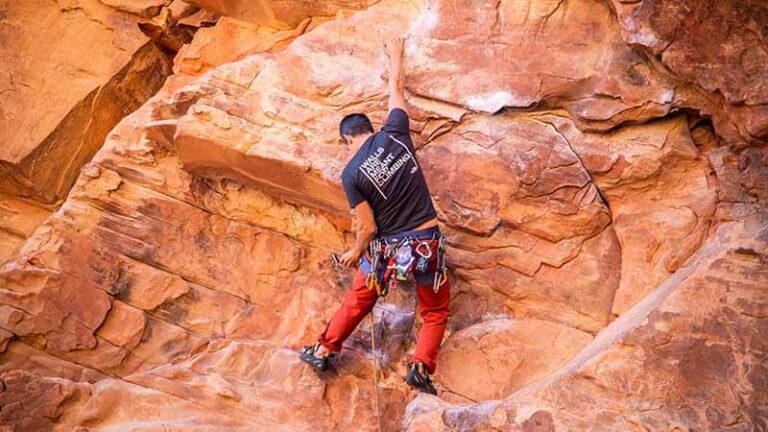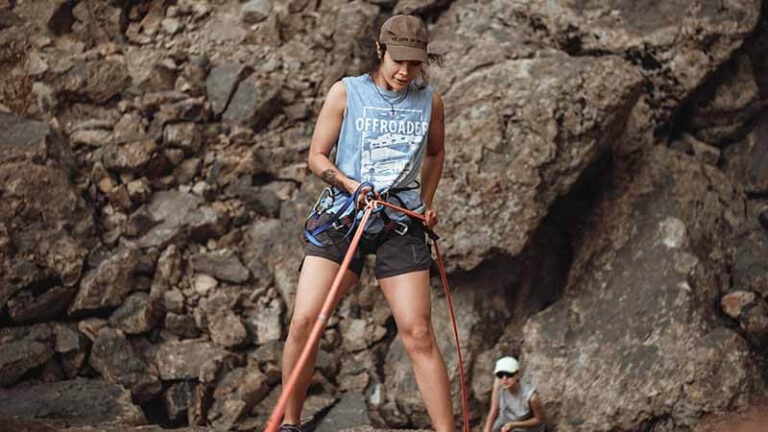Is Bouldering Harder Than Rock Climbing?
Bouldering and rock climbing are two distinct types of climbing that entail mounting vertical surfaces, although they differ significantly.
Bouldering is a style of climbing that involves ascending short, difficult routes without ropes that are often no more than 15 to 20 feet high. Climbing takes place on boulders or low cliffs, and the climber must rely on strength, technique, and balance to ascend the rock wall.
Bouldering routes are referred to as problems, and they are graded according to their difficulty. Bouldering is usually done inside artificial walls or outside on natural rock formations.
On the other hand, rock climbing entails ascending considerably taller rock faces while employing ropes, harnesses, and other safety equipment. Rock climbing can be done on a number of rock types, such as granite, sandstone, and limestone, and routes can be hundreds or thousands of feet long. Rock climbing routes, like bouldering routes, are graded depending on their difficulty, although the grading method used for rock climbing differs from that used for bouldering.
There are various reasons why comparing bouldering with rock climbing is significant. For starters, it assists climbers in understanding the differences between the two forms of climbing and the many abilities and techniques required for each. This can assist climbers in determining which sort of climbing they want to pursue and what type of training they will need to be successful.
Second, contrasting bouldering and rock climbing can assist climbers in setting goals and tracking their development. Climbers can establish goals to climb progressively difficult routes or difficulties and track their progress over time by learning the grading systems for each form of climbing.
Finally, contrasting bouldering with rock climbing can help climbers comprehend the distinct challenges and rewards of each. While both require strength, technique, and mental focus, they provide different experiences and necessitate different strategies to succeed. Climbers can get a deeper appreciation for the art and science of climbing by learning the differences between bouldering and rock climbing.
Bouldering vs. Rock Climbing: Key Differences
Bouldering and rock climbing are two distinct types of climbing with significant differences.
Equipment and Gear
The equipment and gear utilized are one of the key distinctions between bouldering and rock climbing. Bouldering usually requires only climbing shoes, chalk bags, and crash pads, whereas rock climbing requires a more full set of equipment such as ropes, harnesses, carabiners, and belay devices. Bouldering equipment is often less expensive and easier to transport than rock climbing equipment.
Technique and Style
Bouldering and rock climbing differ in technique and style as well. Bouldering frequently necessitates more aggressive, dynamic action than rock climbing, with climbers leaping and lunging to grab grips. Rock climbing, on the other hand, requires more persistent, static action, with climbers depending on strength and balance to keep their place on the rock face.
Types of Routes and Difficulty Levels
Bouldering routes, often known as “problems,” are typically shorter in length and demand more intensive, focused effort to finish. Rock climbing routes, on the other hand, can be substantially longer, sometimes requiring many hours or even days to accomplish, and may demand more endurance than strength.
Grading systems for bouldering and rock climbing routes are also distinct. Bouldering issues are graded using the V-scale, whereas rock climbing routes are graded using the Yosemite Decimal System.
Safety
Both bouldering and rock climbing are concerned with safety, but the level of risk varies. Bouldering is a safer kind of climbing because climbers are never more than a few feet off the ground and do not require ropes. Rock climbing, on the other hand, requires higher elevations and the usage of ropes, which can be dangerous if not handled correctly.
While bouldering and rock climbing have many similarities, they also have significant differences. Understanding these distinctions can assist climbers in selecting the type of climbing that best meets their goals and abilities, as well as ensuring that they have the necessary equipment and procedures to climb safely and successfully.
Difficulty Level of Bouldering
Bouldering grades
Bouldering, like rock climbing, has a grading system to denote the climb’s difficulty level. Bouldering grades are often designated by a letter followed by a number, with the letter representing the degree of difficulty and the number representing the precise difficulty within that level.
Bouldering grading systems differ by geography, with different countries employing distinct systems. The V-scale, which is mostly used in North America, goes from V0 (very easy) to V17 (very tough). The Fontainebleau grade system, which spans from 1 (easiest) to 9b (hardest), is more generally used in Europe.
Factors that affect the bouldering difficulty
The size and shape of the holds, the angle and texture of the rock surface, and the length and complexity of the route all influence the difficulty level of a bouldering issue. Bouldering issues with small, slick grips or overhanging surfaces are generally harder than problems with larger, more solid holds and less steep slopes. The difficulty level is also affected by the length of the journey, with longer routes requiring greater endurance and stamina.
Examples of difficult bouldering problems
There are several examples of tough bouldering issues all across the world, with some of the most difficult challenges requiring elite-level strength, technique, and mental focus to execute. One such example is the famed V15 problem “The Nest” in Red Rock Canyon, Nevada, which has only been climbed by a few elite climbers. Another example is the 8C (V15) boulder problem “Dreamtime” in Cresciano, Switzerland, which was the world’s first 8C boulder problem.
Other challenging bouldering difficulties include “The Story of Two Worlds” in Cresciano, Switzerland, rated V15, and “The Wheel of Life” in Grampians National Park, Australia, rated V16 and widely regarded as one of the world’s most difficult bouldering problems.
Bouldering is a difficult hard-climbing technique that demands a combination of strength, technique, and mental focus. Climbers of all levels, with the proper training and equipment, can enjoy the excitement and satisfaction of overcoming difficult bouldering difficulties.
Difficulty Level of Rock Climbing
Rock climbing grades
Like bouldering, rock climbing has a grading system to signify the difficulty level of the climb. Rock climbing grading systems are often expressed by a numerical scale, with higher numbers denoting increasing levels of difficulty. The Yosemite Decimal System, which spans from 5.0 (very easy) to 5.15 (very tough), is the most widely used grading system in the United States.
Factors that affect rock climbing difficulty
The angle and texture of the rock surface, the size and form of the holds, the length and intricacy of the route, and the quantity of protection available are all elements that might influence the difficulty level of a rock climbing route. Routes with high, overhanging surfaces and small, slippery holds are often considered more challenging than routes with larger, more solid holds and less steep terrain. Longer routes can often be more difficult because they require more endurance and stamina.
The amount of protection available can also influence the level of difficulty of a rock climbing route. Traditionally protected routes, where the climber puts their own protection gear, might be more difficult than sport routes, where bolts are already installed in the rock for protection. The most difficult and dangerous kind of rock climbing is free soloing, in which the climber climbs without the use of ropes or other protective gear.
Examples of difficult rock climbing routes
There are several instances of tough rock climbing routes all around the world, and some of the most difficult climbs necessitate elite-level strength, technique, and mental focus to complete. One such example is the 5.15d route “Silence” in Flatanger Cave, Norway, which is now the hardest sport climbing route in the world. Another example is the 5.15d rated “Perfecto Mundo” in the limestone cave of El Bovedón, Mexico.
Other tough rock climbing routes include 5.15c “La Dura Dura” in Oliana, Spain, and 5.15b “Jumbo Love” in Clark Mountain, California, which is one of the world’s hardest conventional climbing routes.
Rock climbing is a difficult and demanding activity that involves strength, technique, and mental attention. Climbers of all abilities can enjoy the excitement and satisfaction of tackling difficult rock climbing routes with the proper training, equipment, and support.
Which is Harder: Bouldering or Rock Climbing?
Whether bouldering or rock climbing is more difficult is a question of opinion that ultimately depends on the individual climber’s experience, skill level, and personal preferences. While some climbers may prefer bouldering due to its emphasis on power and technique, others may prefer rock climbing due to its endurance and mental demands.
Physical fitness, mental resilience, technical ability, experience level, body type, and personal preferences are all elements that might influence an individual’s impression of difficulty in bouldering and rock climbing. A climber with a gymnastics background, for example, may find bouldering motions more natural and fluid, but a climber with endurance sports experience may succeed at longer rock climbing routes.
Climbers who favor high-intensity, explosive movements may choose bouldering, whereas climbers who prefer problem-solving and mental challenges may prefer rock climbing.
While there is no definitive answer as to whether bouldering or rock climbing is more difficult, experts generally agree that both sports provide distinct challenges and benefits. Bouldering necessitates explosive strength and technical precision, but rock climbing necessitates endurance, mental attention, and problem-solving abilities.
Finally, the best way to tell which sport is more difficult is to try both and see which one provides the most challenge and satisfaction for each individual climber.
Conclusion
Personal goals and preferences must be considered when deciding between bouldering and rock climbing. Each sport has its own set of problems and advantages, and what works for one climber may not work for another. Climbers can choose the sport that best fits their interests and provides the most happiness and enjoyment by taking their particular aims and preferences into account.
Climbers who value endurance, mental focus, and problem-solving, for example, may favor bouldering, whereas those who value explosive power, dynamic movements, and technical perfection may choose rock climbing. Climbers who appreciate the social side of the sport, such as rock climbing, may prefer it, while those who prefer a lonely experience may prefer bouldering, which may be done alone or with a small group of friends.
Personal objectives can play a factor in deciding between bouldering and rock climbing. Bouldering may be a better alternative for competitive climbers because it has a well-established competition circuit and focuses on shorter, more explosive climbs. On the other hand, climbers who want to tackle longer, more difficult routes may prefer rock climbing, which provides a wider range of obstacles and chances for exploration.

